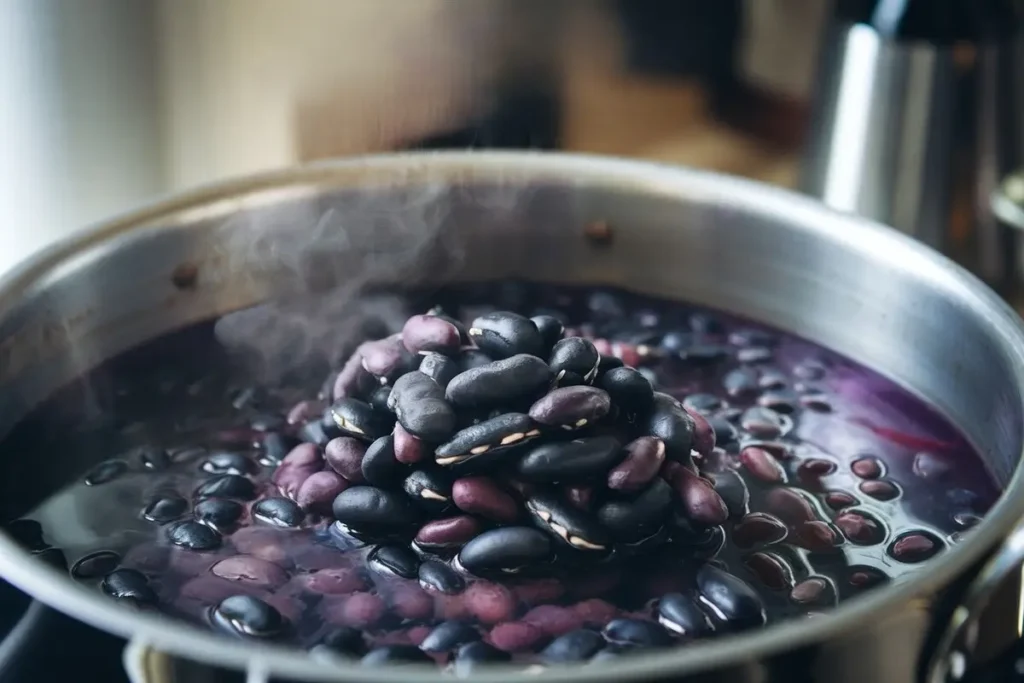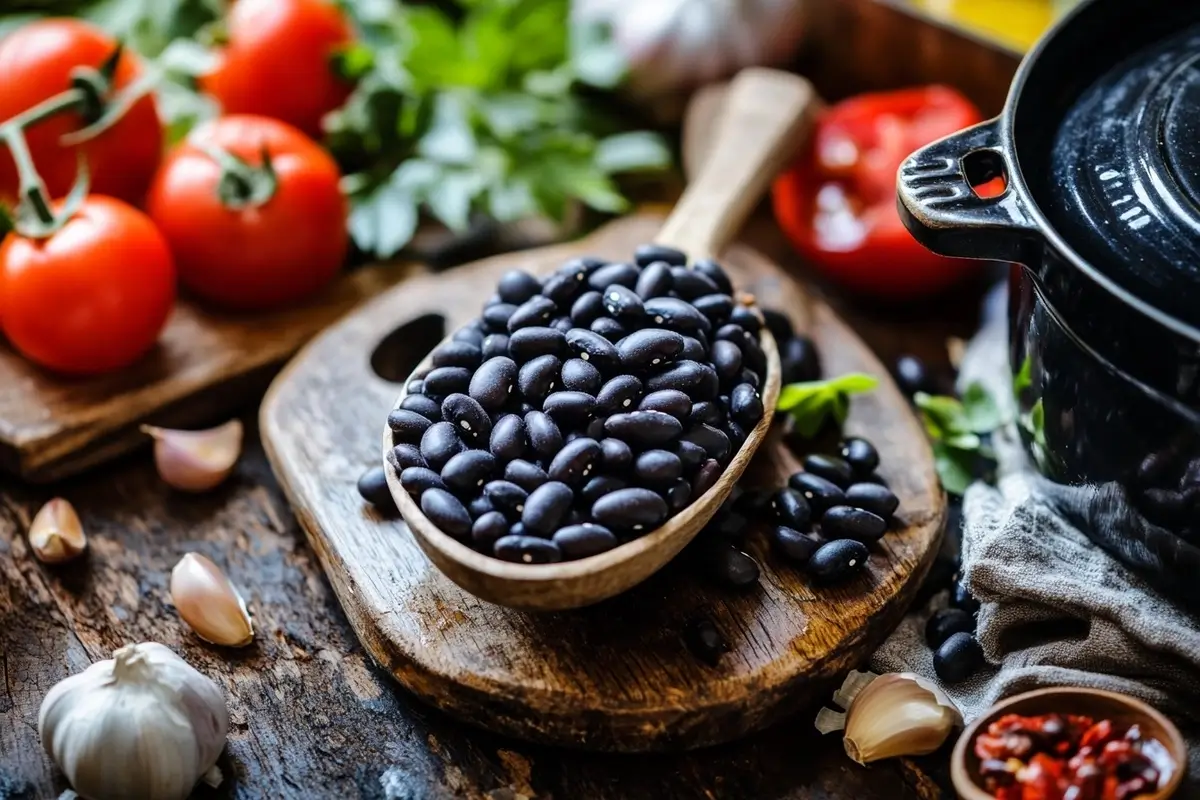Black beans are a staple in many kitchens worldwide, offering rich flavor, versatility, and a host of nutritional benefits. However, if you’ve ever cooked them, you may have noticed something unusual: black beans sometimes turn purple during cooking. This color change can be perplexing, but natural reactions cause it, driven by factors like cooking methods, water pH, and the chemistry of the beans themselves.
In this article, we’ll explore the reasons behind this fascinating transformation and give you tips on how to prevent it. Whether you’re a culinary novice or an experienced cook, understanding why black beans turn purple can help you master your cooking techniques and make the most of this nutritious legume.
Table of contents

Understanding Black Beans and Their Color
Before diving into why black beans change color, it’s important to understand what makes these beans black in the first place. This section will explain the natural pigments that give black beans their dark color and the factors that can influence this process.
What Are Black Beans?
Black beans, also known as turtle beans, are small, oval-shaped legumes with a distinctive black skin. You can commonly find black beans in various dishes, from soups to salads, and people prize them not only for their rich flavor but also for their high nutritional content. Packed with protein, fiber, and essential nutrients, black beans make a popular choice for plant-based diets.
Typically small and shiny, black beans have a smooth texture that allows them to absorb the flavors of any dish they are cooked in. Whether you’re preparing a hearty chili or a Mexican-inspired burrito, these beans hold their shape well when cooked, which is one reason why they are so beloved.
What Causes the Dark Color of Black Beans?
The distinctive black color of these beans comes from a class of pigments called anthocyanins. These natural compounds are responsible for the deep, rich hues found in many fruits, vegetables, and legumes. Anthocyanins act as antioxidants, offering various health benefits, including fighting free radicals and supporting heart health.
While the anthocyanin pigments give black beans their color, it’s also important to note that the overall color of the beans can be influenced by the way they are prepared. Factors such as temperature, cooking time, and even water pH can all play a role in altering the appearance of these otherwise black beans. Understanding how these pigments work is crucial when trying to prevent or predict any unexpected color changes, such as the purple transformation that occurs during cooking.
Why Do Black Beans Turn Purple?

Now that we’ve understood a bit about black beans and their natural color, let’s dive into the question: Why do black beans turn purple? This part will focus on the primary factors contributing to this unusual color change during cooking and soaking.
The Impact of Cooking on Bean Color
One of the most common reasons black beans turn purple is due to the cooking process itself. When you heat up black beans, the anthocyanins within the beans react to the heat. High temperatures, especially when they are cooked for a long time, can break down the beans’ cellular structure, releasing these pigments into the surrounding water.
But that’s not all. The type of cookware you use can also have an impact. For example, cooking beans in a metal pot with an acidic surface (like aluminum) can sometimes accelerate the reaction. On the other hand, a non-reactive pot, such as one made from stainless steel or enamel-coated cookware, is less likely to cause color shifts. In other words, if your black beans are turning purple, your cooking method or the materials you use may be at fault.
Soaking and Color Changes
The soaking process can also cause black beans to lose their color or change it entirely. When beans soak in water, the starches and pigments dissolve into the liquid. The pH level of the water plays a key role in whether black beans stay their dark color or turn purple. For instance, if you soak black beans in water that is slightly alkaline, the anthocyanins are more likely to leach out, resulting in a purple hue.
Interestingly, soaking black beans in hard water (which is high in minerals like calcium and magnesium) can also cause color changes. So, if you live in an area with hard water, you might find that your beans turn purple after soaking, even before you cook them. This is a natural reaction and does not affect the beans’ safety or taste. In fact, the purple color is just a sign of the pigments interacting with the minerals in the water.
Scientific Explanation Behind the Color Shift
Let’s take a closer look at the science behind why black beans turn purple. The explanation boils down to the chemistry of the beans and how they react to different conditions during cooking and soaking. Understanding these reactions will give you a better grasp of how to prevent or embrace this color change.
The Role of pH in Color Changes
As we’ve mentioned earlier, pH plays a significant role in the color of black beans. The anthocyanins responsible for the dark color in black beans are pH-sensitive. When the pH of the environment is acidic, the beans tend to stay darker, often maintaining their original black color. However, when exposed to an alkaline environment, the pigments can shift, turning the beans purple or blue.
For example, adding an alkaline substance like baking soda to your cooking water can cause the beans to change color. This happens because baking soda increases the pH of the water, making it more alkaline, and thus affecting the pigments in the beans. If you’re trying to preserve the natural dark color of black beans, it’s best to avoid high-alkaline substances unless you’re aiming for that purple hue.
Enzymatic and Chemical Reactions
In addition to pH, other chemical and enzymatic reactions contribute to the color shift. As the beans cook, oxygen in the air can interact with the anthocyanins, causing them to oxidize and change color. This is similar to how apples or potatoes brown when exposed to air. Beans, however, undergo a more complex process when cooked at high temperatures or in a high-pH environment, which can lead to the purple color.
It’s also important to remember that these reactions don’t necessarily indicate spoilage or poor quality. In fact, the color shift is purely aesthetic, and the beans are still perfectly safe to eat. So, while you might be curious about why black beans turn purple, rest assured that the change in color doesn’t affect their taste or nutritional value.
How to Cook Black Beans Without Turning Them Purple
Cooking Method Matters
If you’ve ever wondered, Why do black beans turn purple when cooking them, here’s a simple answer: it all comes down to the cooking process. Beans can change color due to the interaction of heat with their natural pigments. However, by using the right cooking method, you can avoid this color shift. For example, using the slow cooker on a low heat setting helps prevent color changes. On the other hand, cooking them on high heat for too long may encourage the beans to turn a strange hue.
You can also soak your beans overnight before cooking. This process helps to release certain enzymes and can also make the beans softer, reducing the chances of color changes. Whether you’re preparing a classic black bean soup or a simple side dish, make sure to maintain a gentle simmer to keep those beans looking their best.
The Power of Acidity
Black beans may also turn purple or bluish in an acidic environment. Ingredients like tomatoes, vinegar, or citrus can interact with the anthocyanins in the beans, causing the color change. While this doesn’t affect the taste, be mindful of how these ingredients influence the final dish.
Tips to Avoid Purple Beans:
- Soak the beans before cooking
- Cook beans over low heat
- Avoid acidic ingredients until the beans are fully cooked
By paying attention to these simple steps, you can prevent your beans from turning purple and keep your dishes looking as vibrant as they taste.
Are Purple Black Beans Safe to Eat?
No Need to Worry About Purple Beans
If you’ve accidentally cooked black beans and noticed them turning purple, you might be asking, Why do black beans turn purple and whether they are safe to eat. The good news is that there’s absolutely no harm in consuming beans that have turned a different color. The color change is purely aesthetic and doesn’t indicate that the beans are spoiled or unsafe. It’s simply a reaction involving anthocyanins and other natural compounds found in the beans.
That said, if you’re looking to keep your black beans looking their usual deep, dark color, it’s best to stick to the cooking tips outlined above.
The Nutritional Benefits Remain the Same
Even if your beans turn purple, rest assured the nutritional value stays unchanged. Black beans are packed with fiber, protein, and essential vitamins and minerals. They are an excellent source of iron, magnesium, and folate, regardless of their color. In fact, anthocyanins—the same compounds responsible for the color shift—are also antioxidants, adding a bit of extra health benefit to your meal.
For more delicious recipe ideas, check out this tasty dish, which features black beans in all their glory!
Why Do Black Beans Lose Their Color Over Time?
The Effect of Storage Conditions
When it comes to black beans, their color is sensitive to environmental factors. One reason your beans might lose their deep black color over time is improper storage. Beans that are exposed to light, heat, or moisture for prolonged periods can fade or discolor. This is a result of the degradation of the natural pigments, primarily anthocyanins, which are sensitive to these elements.
For example, storing beans in a clear plastic container or near sunlight can speed up fading. Beans kept in non-airtight containers may also absorb moisture, affecting both color and texture.
Aging Beans: What Happens to Their Color?
Another key factor that affects the color of black beans is their age. Like many dried foods, black beans can change in appearance as they age. Over time, they may lose their rich, dark hue, becoming lighter or even taking on a slightly faded look. This doesn’t mean they’re spoiled, but it’s a sign that their quality may be diminishing.
Best Practices for Storing Black Beans:
- Store beans in dark, cool, and dry places
- Use airtight containers to prevent moisture exposure
- Consume within a year of purchase for best quality
By following these simple tips, you can keep your beans looking and tasting their best, without the worry of losing their original color.
Common FAQs About Black Beans and Their Color
Why Did My Black Beans Turn Purple?
If your black beans turned purple during cooking, you might wonder why and if they’re safe to eat. As mentioned, purple beans are perfectly safe! This color change happens because of anthocyanins reacting to heat or acidity. It’s common and doesn’t mean the beans are spoiled. If you prefer the classic dark color, follow the tips from earlier to cook them that way.
How Can You Tell if Black Beans Have Gone Bad?
When black beans go bad, the most noticeable sign is a change in texture, smell, and color. Fresh, properly stored beans will have a firm texture and a neutral, earthy smell. However, when beans go bad, they may develop an off-putting odor, become mushy, or exhibit a very different color, such as a yellowish or greenish tint. If your beans are showing signs of mold or an unusual smell, it’s best to discard them.
Are Black Beans Actually Purple?
While black beans are typically deep black in color, they are sometimes mistakenly thought to be purple. In fact, when cooked improperly or under certain conditions, black beans can indeed take on a purple hue, as we’ve discussed. But no, black beans are not actually purple in their raw form—it’s simply a cooking or storage quirk.
Why Do Black Beans Lose Their Color?
Over time, black beans can lose their color due to age, improper storage, and exposure to heat and light. To maintain their deep color, store them in a cool, dry, dark place, and use them within a year for best freshness.
For more useful cooking tips and bean-related recipes, check out this guide to cooking dried beans.
Conclusion: Embracing the Mystery of Purple Black Beans
In conclusion, why do black beans turn purple? The answer lies in the beans’ natural chemistry. Heat, pH changes, and soaking or storage conditions all play a role in the color shift. These changes are natural and do not affect the beans’ safety or taste. The purple hue simply results from anthocyanin pigments reacting to certain conditions.
Understanding these processes helps you control the color of your beans, whether you’re soaking or cooking them. Follow the tips in this article, like using non-reactive cookware, controlling the pH of your cooking water, and storing beans properly, to keep your black beans looking their best.
Whether your beans turn purple or not, their nutritional value and flavor remain unchanged. So, if your black beans change color, don’t worry—it’s just part of the natural process!
For more recipes and tips on cooking black beans and other legumes, check out the recipe section for fresh ideas.

